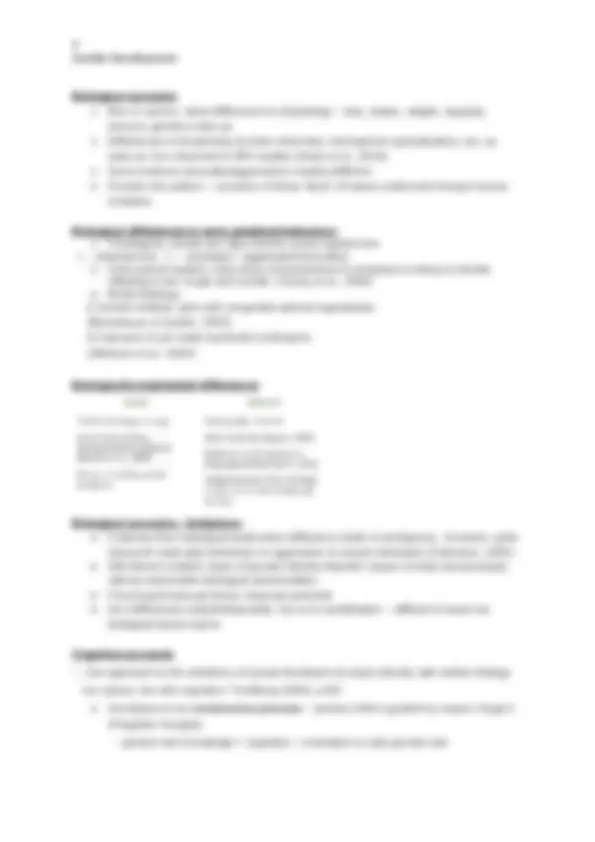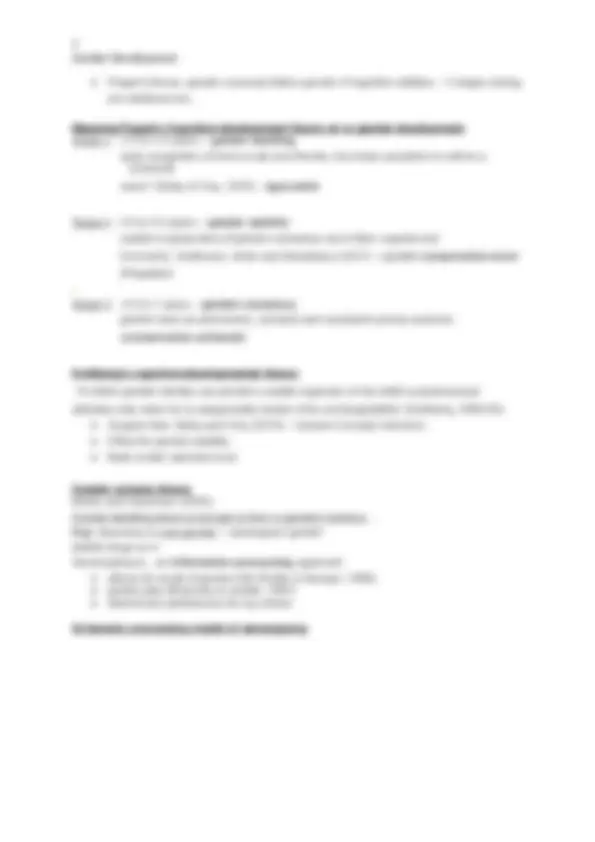





Study with the several resources on Docsity

Earn points by helping other students or get them with a premium plan


Prepare for your exams
Study with the several resources on Docsity

Earn points to download
Earn points by helping other students or get them with a premium plan
Community
Ask the community for help and clear up your study doubts
Discover the best universities in your country according to Docsity users
Free resources
Download our free guides on studying techniques, anxiety management strategies, and thesis advice from Docsity tutors
lecture notes and study notes developmental psychology
Typology: Lecture notes
1 / 7

This page cannot be seen from the preview
Don't miss anything!




Gender Development – Lecture 6 (part 1) The main focus: Basic concepts Social learning accounts Biological accounts Cognitive accounts Lifespan perspectives Gender…
emotional & behavioural attributes associated with gender group membership… including stereotypes produced & reproduced by upbringing & social convention.
created once we have been assigned our sex at birth (based on biological characteristics: genitals) What do we mean by Gender?
themselves belong to one of them? When do they begin to understand gender constancy?
‘be like’ girls)?
“boys’ stuff” or “girls’ stuff”? And which are ‘for them’? Gender: Key Concepts Gender labelling: Recognition of the two sexes; correct identification of oneself & others as male or female
More sophisticated knowledge Gender stability – idea that gender is normally stable over time – that it is a permanent group membership ◦“Are you a boy or a girl?”… “Girl” ◦ “When you grow up, will you be a daddy or mummy?”... “A daddy” Gender constancy – gender group membership cannot be changed after temporary superficial transformation ◦“If a boy grows his hair really long & wears a dress, will he be a boy or a girl?” (“A boy!”) ◦To a boy: “If you really want to be a girl, can you be a girl?” (“No!”) A simple gender constancy testing procedure: Better performance if children know genital differences (Bem,1989) Thinking and Behaviour
e.g. “play with dolls/cars”; “like to talk/ fight”, “strong”, “soft-hearted”
the way boys and girls play; e.g. more same-sex friends; stereotyped toys in bedroom Social Learning accounts Different societies hold different conceptions of gender-typical behaviour & such expectations change over time – environment must play a role Child as a recipient of social information: ügender identity is acquired (rather than given by genes or constructed by child) üproduct of accumulating learning experiences Socialising agents: parents, teachers, peers, media
reinforcement and modelling
punishment
gender norms & illustrations of conforming/not conforming to norms Adult reinforcement à Will, Self and Datan (1976) classic study of sex-typing (‘Baby X’): Same baby dressed in different colours: ADAM or BETH Adults can choose from 3 toys: TRAIN or DOLL or FISH “Beth” gets doll more often and receives more smiles à Caldera, Huston and O’Brien (1989): 18 to 23mo child receives positive responses for picking up role-appropriate toys, negative ones for inappropriate toys Adult modelling gender “labels”: doll – girls; truck – boys Ascribing a label to object – sex-typing (stereotypes)
labels more quickly
effects of modelling Peer influence Gender is dominant force in peer playmate preference, regardless of ethnicity (Halim et al.
inappropriate activities
“Daddies don’t cook”
Biological accounts Men & women: clear differences in physiology – size, shape, weight, capacity, amount, genetic make-up Differences in functioning by brain chemistry, hemispheric specialisation, etc, as early as 1mo observed in MRI studies (Dean et al., 2018) Some instincts (sexuality/aggression) notably different Gender-role pattern – outcome of those ‘facts’ of nature evidenced through human evolution Biological differences in early gendered behaviour If biological, should see signs before social experiences ♂ – testosterone; ♀ – oestrogen (aggression/sexuality) Early animal studies: extra dose of testosterone to pregnant monkeys à female offspring more ‘rough and tumble’ (Young et al ., 1964) Mixed findings: à Genetic defects: girls with congenital adrenal hyperplasia (Berenbaum & Synder, 1995) à Exposure to pre-natal (synthetic) androgens (Atkinson et al. , 2000) Biologically-engineered differences Biological accounts - limitations Evidence from biological dysfunction difficult to obtain & ambiguous...However, quite strong for early play behaviour or aggression & sexual orientation (Patterson, 1995) Still doesn’t explain cases of gender identity disorder (cases of early transsexuals) without observable biological abnormalities Freud psychosexual theory: bisexual potential Sex differences early/indisputable, but so is socialisation – difficult to tease out biological factors alone Cognitive accounts “…Our approach to the problems of sexual development starts directly with neither biology nor culture, but with cognition.” Kohlberg (1966; p.82) Development as constructive process – (active) child is guided by reason (“logic”) (Piagetian thought):
Piaget’s theory: gender concepts follow growth of cognitive abilities – 3 stages during pre-adolescence... Mapping Piaget’s Cognitive-development theory on to gender development Stage 1 - 2.5 to 3.5 years – gender labelling early recognition of terms male and female, but treats ascription to self as a “personal name” (Slaby & Frey, 1975) - egocentric Stage 2 - 3.5 to 4.5 years – gender stability unable to grasp idea of gender constancy (as in Bem experiment) Emmerich, Goldmann, Kirsh and Sharabany (1977) – parallel conservation error (Piagetian) ◦ Stage 3 - 4.5 to 7 years – gender constancy gender seen as permanent, constant and consistent across contexts ( conservation achieved ) Kohlberg’s cognitive-developmental theory “A child’s gender identity can provide a stable organizer of the child’s psychosexual attitudes only when he is categorically certain of its unchangeability” (Kohlberg, 1966:95). Support from Slaby and Frey (1975) – Gender Concept Interview: Effect for gender stability Male model watched more Gender schema theory Martin and Halverson (1981): Gender labelling alone is enough to form a (gender) schema… Key : discovery is own gender – subsequent gender beliefs hinge on it Stereotyping is…an information processing approach: allows for recall of gender info (Ruble & Stangor, 1986) guides play (Maccoby & Jacklin, 1987) determines preferences for toy choice Schematic processing model of stereotyping
Biological accounts: behavioural tendencies triggered by sex differences due to genes & evolved characteristics Cognitive accounts: child’s role in constructing identity using recognition & knowledge of their group membership Need for a transactional model